23 January, 1999
Saturday, January 23rd, South Pole Station
What a busy day we had! Hope yours was good as well.
The temperature was still - 22C. The wind had calmed down, though not
as much as we wanted (15 knots), but we made an attempt to launch our
plastic balloon anyway to review the winter balloon procedure before
Bryan's leave. We had an early start with "on the day of flight
preparations" for the 2Z-ozone model which I discussed earlier. Andy
and Joel were trying to launch this large balloon on their own because
they would have to do it all winter long. The plastic balloons need
to be used in the winter because the latex balloon, which we use in
the summer, would become brittle in temperatures of - 75 to - 85
degrees of Celsius. Starting at 7:30 am with all the preparations, we
were ready to launch at 10:30am.
The filling of the balloon was an interesting procedure (see photos).
The balloon had an extension attached that needed to be held carefully
during launching. Since we still had about 15 knots of wind to deal
with we were hoping all would go well and it did. As Joel let go of
the balloon, Andy needed to run in the direction of the wind and then
let go of the ozonesonde together with the balloon. These plastic
balloons will be used until October - which means that they are also
used during the ozone-hole-formation.
The flight was done at 12:30, just in time to pick up Dr. Dave Hofmann
from the plane. The whole NOAA group had lunch together (those baked
deserts are truly something). Bryan and I took care of last-minute
issues regarding the transfer of data and future communication, and at
4:30p.m we brought him to the plane that will bring him to McMurdo
with continuation to Christchurch. I caught up with emailing and
answered questions students had and then joined the NOAA group (Joel,
Andy, and Dave) for dinner (we had pizza - it must be Saturday). A
social gathering followed and Dave spoke a lot about the earlier years
in ozone research. The stories were interesting and helped me to
answer yesterday's questions about when and how was the ozone hole
discovered.
History of the ozone hole research:
I have discussed before that DOBSON suggested that ozone is important
for our protection from UV light. because it absorbs the UV. He also
found natural fluctuations in ozone level depending on the season, the
time of the day, and the location in the world. JOE FARMAN from the
United Kingdom (British Antarctic Survey) is credited with having
discovered the ozone hole in 1985 by observing a decrease in total
ozone in late September through October at Halley Bay, Antarctica.
DAVE HOFMANN, my PI, parcticipated in the 1986 National Ozone
Expedition (NOZE) to provide the airborne ozone data profiles, which
told which ozone of which the region of the atmosphere was being
destroyed. SUE SOLOMON from the NOAA Aeronomy Laboratory, also in
Boulder, Colorado, was a member of NOZE as well and worked with a
spectrometer on the ground which was capable observing trace gases in
the stratosphere such as nitrogen dioxide and molecules which
contained chlorine. She has proposed a theory to explain ozone
depletion. Her theory involved the chemistry which takes place on tiny
parcticles in the clouds which form in the winter Antarctic
stratosphere - Polar Stratospheric Clouds. Based on their
observations, the NOZE group concluded that the ozone hole was
basically the result of chemistry involving chlorine which is mainly
man-made.
This initial work was done in McMudo. Both, Hofmann and Solomon,
collected their data during WINFLY which stands for 'Winter flights
into Antarctica'. The Winfly season starts in late August when it is
still dark in the Antarctic. Its main purpose is to fly people into
the Antarctica to prepare the runways for aircraft operations during
the summer season. When the sun rises in the Antarctica, the ozone
hole is formed. Why is the ozone hole formed during the Antarctic
spring and why does the hole appear - in all places in the world ---
over the Antarctic? Is the Ozone hole a true gap in the atmosphere?
What are the pollutants that contribute(d) to the depletion of the
ozone. These are questions I received by many of you and I will answer
them tomorrow.
By the way, the Smithsonian Institute in Washington D.C. honored
Hofmann's and Solomon's work and efforts in a very special way. The
institute created a wax-figure exhibition of Hofmann and Solomon and
their field work in the Antarctic as part as the "Science in American
Life" Exhibit. Make sure you go to see it when you are visiting
Washington the next time!!
About 11pm - just before bedtime - I went skiing again. The exercise
did me well and I slept through the night.
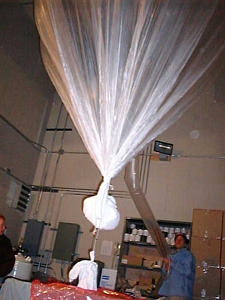
Joel is filling the plastic balloon inside the BIF
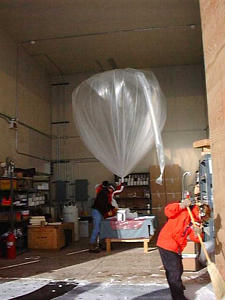
The plastic balloon inside the BIF. Loree, a weather analyst at South Pole, cleaning the entrance.
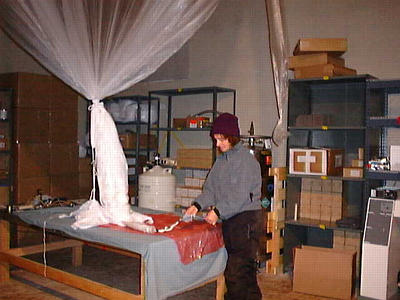
I am inspecting the balloon!
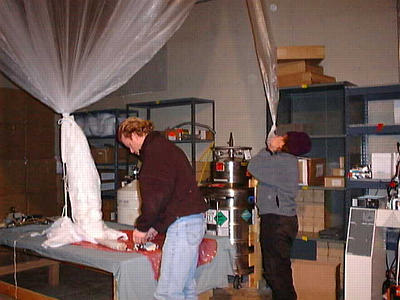
I am helping filling the balloon!!
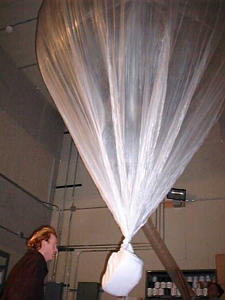
Andy attaching the 'way-off weight' to the balloon.
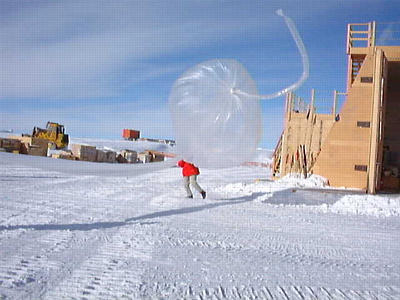
Joel is letting go of the plastic balloon in 15 knots winds.
Contact the TEA in the field at
.
If you cannot connect through your browser, copy the
TEA's e-mail address in the "To:" line of
your favorite e-mail package.
|
